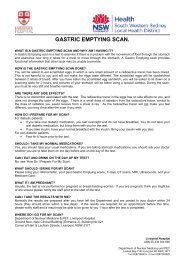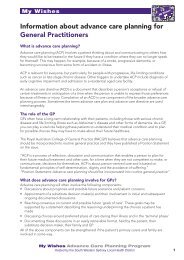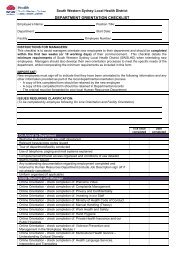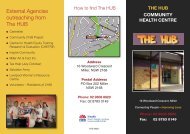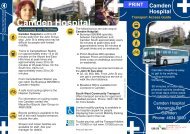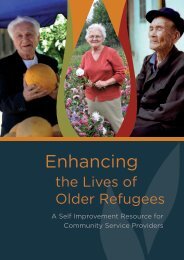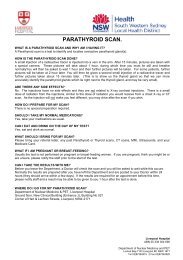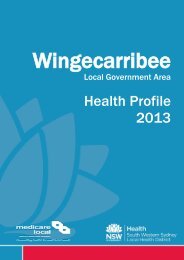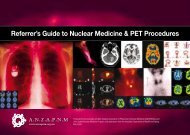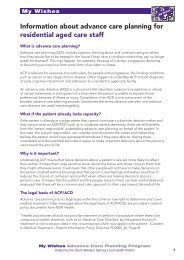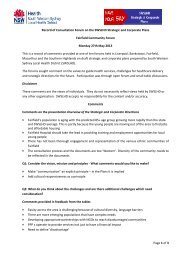Wollondilly - South Western Sydney Local Health District - NSW ...
Wollondilly - South Western Sydney Local Health District - NSW ...
Wollondilly - South Western Sydney Local Health District - NSW ...
- No tags were found...
You also want an ePaper? Increase the reach of your titles
YUMPU automatically turns print PDFs into web optimized ePapers that Google loves.
<strong>Wollondilly</strong> <strong>Local</strong> Government Area <strong>Health</strong> Profile 2013<strong>Health</strong> StatusChronic and preventable diseaseThe following information in Tables 3 reflects the health status of residents of the <strong>Wollondilly</strong> LGA and has beenextracted from the <strong>Health</strong> Statistics <strong>NSW</strong>. The indicators are defined athttp://www.healthstats.nsw.gov.au/ContentText/Display/DefinitionsTable 3: Indicators reflecting health status of residents of the <strong>Wollondilly</strong> LGA and <strong>NSW</strong>Indicator <strong>Wollondilly</strong> <strong>NSW</strong>HospitalisationsHospitalisations 2009-10 to 2010-11, smoothed number of separations per8year (smoothed estimate of Standardised Separation Ratio – seSSR)13,943 (96.5) 2,645,561 (100)Potentially preventable hospitalisations 2010-11 2011-12 smoothed numberof hospitalisations per year (seSSR)955 (95.4) 183,951 (100)Alcohol attributable hospitalisations, 2010-11 to 2011-12, smoothed numberof hospitalisations per year, (seSSR)231 (82.4) 49,410 (100)Smoking attributable hospitalisations, 2010-11 to 2011-12, smoothed numberof hospitalisations per year (seSSR)228 (95.3) 46,120 (100)High body mass index attributable hospitalisations, smoothed number ofseparations per year 2010-11 to 2011-12 (seSSR)205 (105.3) 35,952 (100)Coronary heart disease hospitalisations 2009-10 to 2010-11 smoothednumber of hospitalisations per year (seSSR)263 (106.6) 49,935 (100)COPD Hospitalisations, persons aged over 65, 2009-10 to 2010-11,smoothed number of separations per year (seSSR)65 (104.4) 15,037 (100)Diabetes hospitalisations, 2009-10 to 2010-11, smoothed number ofseparations per year (seSSR)89 (89.4) 19,193 (100)Fall-related injury overnight hospitalisations, persons aged 65 years and over,2010-2011 to 2011-2012 combined, smoothed number of hospitalisations per 125 (95.5) 34,766 (100)year (seSSR)Stroke hospitalisations 2010-11 to 2011-12, smoothed number ofhospitalisations per year (seSSR)51 (93.9) 11,853 (100)DeathsPotentially avoidable deaths, persons aged under 75 years, 2006 to 2007combined, smoothed number of deaths per year, smoothed Standardised 50 (90.4) 10,356 (100)Mortality Ratio (sSMR) 9Potentially avoidable deaths from preventable causes, persons aged under75 years, 2006 to 2007 combined (sSMR)33 (98.6) 6,133 (100)Potentially avoidable deaths from causes amenable to health care, personsaged under 75 years, 2006 to 2007 combined, smoothed number of deaths 19 (85.2) 4,235 (100)per year (sSMR)High body mass index attributable deaths by LGA 2006 2007, (sSMR) 15 (113.0) 2,926 (100)Alcohol attributable deaths, smoothed estimate of standardised mortalityratios per year, 2006 – 2007 (sSMR)6 (100.5) 1,238 (100)Smoking attributable deaths, smoothed estimate of standardised mortalityratios per year, 2006 – 2007 (sSMR)24 (106.4) 5,196 (100)Source: Centre for Epidemiology and Evidence. <strong>Health</strong> Statistics New <strong>South</strong> Wales. <strong>NSW</strong> Ministry of <strong>Health</strong>http://www.healthstats.nsw.gov.au/8 The smoothed Standardised Separation Ratio (SSSR) can be interpreted as a ‘relative risk’, and is compared to the <strong>NSW</strong> average set at 1009 The smoothed Standardised Mortality Ratio (sSMR) can be interpreted as ‘relative risk’ and is compared to the <strong>NSW</strong> average set at of 100pg. 6<strong>South</strong> <strong>Western</strong> <strong>Sydney</strong> <strong>Local</strong> <strong>Health</strong> <strong>District</strong>
<strong>Wollondilly</strong> <strong>Local</strong> Government Area <strong>Health</strong> Profile 2013<strong>Health</strong> Service UtilisationTables 7, 8 and 9 compare utilisation of health services by the <strong>Wollondilly</strong> population with the average for <strong>NSW</strong> andMetropolitan <strong>Sydney</strong>.HospitalisationTable 7: Ten most common reasons for hospital admissions in 2011Group <strong>Wollondilly</strong> (separations/%) <strong>NSW</strong> (separations/%)Dialysis 1,308 (10.6) 336,970 (14.2)Digestive system diseases 1,697 (13.7) 275,265 (11.6)Ill-defined and unknown causes 1,073 (8.7) 188,466 (7.9)Injury and poisoning (including external causes) 1,067 (8.6) 182,136 (7.7)Nervous and sense disorders 994 (8.0) 184,228 (7.8)Maternal, neonatal and congenital causes 910 (7.3) 194,462 (8.2)Musculoskeletal diseases 855 (6.7) 139,342 (5.9)Genitourinary diseases 814 (6.6) 133,963 (5.7)Cardiovascular diseases 735 (6.0) 160,892 (6.8)Respiratory diseases 697 (5.6) 131,586 (5.6)Source: Admitted Patient Data Collection (SaPHaRI); Centre for Epidemiology and Evidence, <strong>NSW</strong> Ministry of <strong>Health</strong>Emergency Department presentationsTable 8 indicates the Emergency Department presentations for residents of <strong>Wollondilly</strong> LGA in 2012 using an ageand sex adjusted standardised incidence ratio (SIR), compared to the metropolitan <strong>Sydney</strong> rate (1.00). The figuresare by triage category with Category 1 being the most serious and Category 5 the least serious conditions.Table 8: ED Presentations standardised Incidence ratio (SIR) 2012Triage<strong>Wollondilly</strong>DescriptionCategoryPresentations SIR1 Resuscitation - Treatment Acuity within seconds 49 0.642 Emergency - Treatment Acuity within 10 minutes 1,305 1.043 Urgent - Treatment acuity within 30 minutes 4,453 1.204 Semi Urgent - Treatment Acuity within 60 minutes 5,622 1.205 Non Urgent - Treatment Acuity within 120 minutes 2,007 1.55Total 13,436 1.22Source: <strong>South</strong> <strong>Western</strong> <strong>Sydney</strong> <strong>Local</strong> <strong>Health</strong> <strong>District</strong> Centre for Research, Evidence Management and Surveillance (HOIST)Primary careTable 9: Medical Benefits Scheme (MBS) services 2009/10 (indirectly age standardised ratio)<strong>Sydney</strong> MetroPresentations7,973126,690370,760452,082125,4421,082,947MBS Service <strong>Wollondilly</strong> <strong>NSW</strong>Total GP services (MBS and DVA) 110 10045 Year Old <strong>Health</strong> Checks by GPs, persons aged 45 to 49 years 107 100Annual health assessments by GPs, persons aged 75 years and over 127 100Total services by GPs for Enhanced Primary Care items 114 100Practice Nurse services under the MBS 118 100Better Access Program: Preparation of Mental <strong>Health</strong> Care Plan by GPs 90 100Source: Medicare Benefits Schedule Data sourced from the Public <strong>Health</strong> Information Development Unit 2012pg. 8<strong>South</strong> <strong>Western</strong> <strong>Sydney</strong> <strong>Local</strong> <strong>Health</strong> <strong>District</strong>
<strong>Wollondilly</strong> <strong>Local</strong> Government Area <strong>Health</strong> Profile 2013<strong>Health</strong> Risk BehavioursTable 10 provides detail regarding health behaviours of <strong>Wollondilly</strong> and <strong>NSW</strong> residents and has been extractedfrom the <strong>NSW</strong> Adult Population <strong>Health</strong> Survey (SaPHaRI); Centre for Epidemiology and Evidence, <strong>NSW</strong> Ministry of<strong>Health</strong>, 2010Table 10: <strong>Health</strong> behaviours of the residents of <strong>Wollondilly</strong> LGA and <strong>NSW</strong> aged 16 years and over 2008 - 2010Indicator <strong>Wollondilly</strong> % <strong>NSW</strong> %Consumes 2 + standard drinks a day when drinking alcohol 33.0 30.4High risk alcohol drinking 8.1 9.5Vaccinated against influenza in the last 12 months by year 73.4 72.4Vaccinated against pneumococcal disease in the last 5 years by year,aged 65 years and over 53.3 56.3Homes with a smoke alarm or detector by year (2005 – 2007) 82.8 84.5Recommended fruit consumption by year 49.7 56.6Recommended vegetable consumption (at least 5 serves per day) 10.6 10.0Adequate physical activity by year 52.9 55.2Current smoking 17.3 17.1Screening mammogram in the last 2 years, females aged 50-69, 2008-10 84.3 76.3Cervical Screening Biennial screening rate, women aged 20 to 69 years,2008-2009 54.8 57.2Source: the <strong>NSW</strong> Adult Population <strong>Health</strong> Survey (SaPHaRI); Centre for Epidemiology and Evidence, <strong>NSW</strong> Ministry of <strong>Health</strong>, 2010Cervical Cancer Screening in New <strong>South</strong> Wales ANNUAL STATISTICAL REPORT 2008–09http://www.cancerinstitute.org.au/media/215408/Cervical%20screening%20annual%20statistical%20report%202008-09.pdf Accessed 05/09/2013Maternal indicatorsMaternal indicators are presented in Table 11 and have been extracted from the <strong>NSW</strong> Adult Population <strong>Health</strong>Survey (SaPHaRI) and Australian Bureau of Statistics 2011.Table 11: Maternal indicators, <strong>Wollondilly</strong> and <strong>NSW</strong>Maternal indicator <strong>Wollondilly</strong> <strong>NSW</strong>Total fertility rate 10 2011 2.08 1.91Smoking at all during pregnancy, 2008 to 2010 combined, number ofmothers who smoked per year, smoothed estimate of standardisedprevalence ratio 110 (115.6) 11,235 (100)First antenatal visit before 14 weeks of gestation, 2008 to 2010 combined,smoothed percent of pregnancies, smoothed standardised prevalenceratio 72% (90.3)Source: Australian Bureau of Statistics, Births, Australia 2011 Catalog No. 33010DO004_2011 Births, Australia, 2011<strong>NSW</strong> Perinatal Data Collection (SAPHaRI). Centre for Epidemiology and Evidence, <strong>NSW</strong> Ministry of <strong>Health</strong>, Accessed 19/09/201279.3% (100)(2010 data)10Total fertility rate represents the number of children a female would bear during her life if she experienced current age-specific fertility rates ateach age of her reproductive life. (ABS 2011)pg. 9<strong>South</strong> <strong>Western</strong> <strong>Sydney</strong> <strong>Local</strong> <strong>Health</strong> <strong>District</strong>
<strong>Wollondilly</strong> <strong>Local</strong> Government Area <strong>Health</strong> Profile 2013MortalityThe life expectancy and deaths from all causes for residents of the <strong>Wollondilly</strong> LGA and <strong>NSW</strong> is provided in Table12. Table 13 provides the top 10 causes of death for the period 2005 – 2007.Table 12: Life expectancy and deaths from all causes for residents of the <strong>Wollondilly</strong> LGA and <strong>NSW</strong>Indicator <strong>Wollondilly</strong> <strong>NSW</strong>Deaths from all causes 2005-2007 StandardisedMortality Ratio (SMR) 11 88.3 100.00Males Females Males FemalesLife expectancy at birth and by gender 2002-2006 80.6 85.1 79.6^ 84.4^Source: <strong>South</strong> <strong>Western</strong> <strong>Sydney</strong> <strong>Local</strong> <strong>Health</strong> <strong>District</strong> Centre for Research, Evidence Management and Surveillance (HOIST) and<strong>NSW</strong> <strong>Health</strong> Chief <strong>Health</strong> Officer’s Report 2010^ Data for <strong>NSW</strong> is derived from 2006/07 data onlyTable 13: Top 10 causes of death 2005 – 2007Causes (by group)<strong>Wollondilly</strong>(count/%)<strong>NSW</strong> (count/%)Cardiovascular diseases 278 (32.3) 83,137 (36.5)Neoplasms - malignant 270 (31.3) 64,841 (28.5)Respiratory diseases 82 (9.5) 19,940 (8.8)Injury and poisoning (including external causes) 72 (8.3) 12,020 (5.3)Endocrine diseases 31 (3.6) 7,191 (3.2)Genitourinary diseases 28 (3.3) 5,425 (2.4)Nervous and sense disorders 27 (3.1) 7,845 (3.4)Digestive system diseases 21 (2.4) 7,624 (3.4)Mental disorders 15 (1.7) 7,316 (3.2)Infectious diseases 13 (1.5) 3,834 (1.7)Source: <strong>South</strong> <strong>Western</strong> <strong>Sydney</strong> <strong>Local</strong> <strong>Health</strong> <strong>District</strong> Centre for Research, Evidence Management and Surveillance (HOIST)ABS Mortality Data (SaPHaRI); Centre for Epidemiology and Evidence, <strong>NSW</strong> Ministry of <strong>Health</strong>Additional information about health status, health behaviours, cancer rates, social capital and health services canbe obtained from <strong>Health</strong> Statistics <strong>NSW</strong>, http://www.healthstats.nsw.gov.au/ ; Cancer Institute <strong>NSW</strong>, CentralCancer Registry Statistical Reporting Module web page, http://www.statistics.cancerinstitute.org.au/ ; and New<strong>South</strong> Wales Population <strong>Health</strong> Survey, 2005 – 2007, Report on Adult <strong>Health</strong>, Macarthur Division of GeneralPractice, http://www.health.nsw.gov.au/resources/publichealth/surveys/hsa_07dgp_mc_pdf.asp11 SMR is observed number of deaths divided by expected number of deaths. Considering the age structure of each LGA, we expect a certainnumber of deaths that we call expected. Then we have actual number of deaths in each LGA as well. The ratio called SMR is a good indicatorfor comparing.pg. 10<strong>South</strong> <strong>Western</strong> <strong>Sydney</strong> <strong>Local</strong> <strong>Health</strong> <strong>District</strong>
<strong>Wollondilly</strong> <strong>Local</strong> Government Area <strong>Health</strong> Profile 2013Social Determinants of <strong>Health</strong>The Social Determinants of <strong>Health</strong> can be described as the economic and social conditions that influence individualand group differences in health status, including the social environment, physical environment, health services, andstructural and societal factors e.g. early years' experiences, education, economic status, employment, housing,transport, access to care, access to resources and the built environment.Socioeconomic Indices for Areas (SEIFA)SEIFA stands for Socio-economic Indexes for Areas. The indexes are used to rank geographic areas acrossAustralia according to their socio-economic characteristics. The Index of Relative Socioeconomic Disadvantage(IRSD) contains indicators of disadvantage such as low income, high unemployment and low levels of education.Relative disadvantage is associated with a low number. The IRSD for the <strong>Wollondilly</strong> was 1,033 in 2011.Theaverage across Australia is 1,000. A number below 1,000 indicates lower socioeconomic status.Within the <strong>Wollondilly</strong> LGA there are areas with varying levels of disadvantage. Suburbs falling below the 1,000reference point include: Menangle Park 969, Yanderra 969, Oakdale (<strong>NSW</strong>) 988 and Couridjah 998Further information about SEIFA and SEIFA scores is available on the ABS web pagehttp://www.abs.gov.au/ausstats/abs@.nsf/mf/2033.0.55.001/Additional data relating to the social determinants of health including educational attainment, dwellings,employment and income is presented in Table 2 and is also accessible via the ABS web pagehttp://www.censusdata.abs.gov.au.Social capitalSocial capital is a term used to describe social relationships within a group or community, for example the extent oftrust between people; whether they have a shared understanding of how they should behave toward, and care forone another; and the extent of participation in civic organisations, such as sporting clubs and school councils. 12Higher levels of social capital and social trust contribute to positive social outcomes.Table 14: Social capital persons aged 16 and over, <strong>NSW</strong> 2007-2009<strong>Wollondilly</strong> % <strong>NSW</strong> %Social CapitalMost people can be trusted 67.4 71.3Feels safe walking down their street after dark 74.0 72.4Area has a reputation for being a safe place 86.6 75.7Visited neighbours in the last week 51.1 61.8Ran into friends and acquaintances when shopping in local area 87.0 82.0Would feel sad to leave their neighbourhood 72.7 73.4Source: <strong>NSW</strong> Adult Population <strong>Health</strong> Survey (SAPHaRI), Centre for Epidemiology and Evidence, <strong>NSW</strong> Ministry of <strong>Health</strong>Other relevant information which may be of interest includes crime rates which are accessible on the New <strong>South</strong>Wales Bureau of Crime and Statistics and Research web page: http://www.lawlink.nsw.gov.au/bocsar12 Social Inclusion as a determinant of mental health and wellbeing – Vic<strong>Health</strong> http://www.copmi.net.au/images/pdf/Research/social-inclusionfact-sheet.pdfpg. 11<strong>South</strong> <strong>Western</strong> <strong>Sydney</strong> <strong>Local</strong> <strong>Health</strong> <strong>District</strong>



